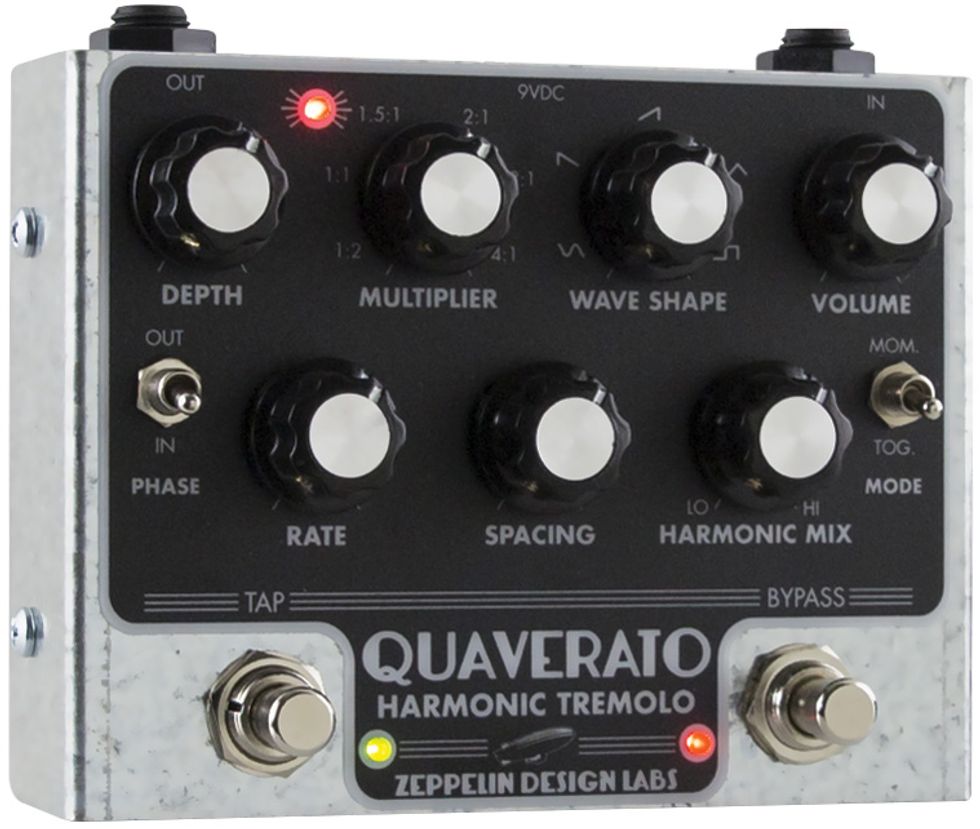RatingsPros:Many customization options. Nicely made. Cons: Mono only. Street: $189 Zeppelin Design Labs Quaverato zeppelindesignlabs.com | Tones: Ease of Use: Build/Design: Value: |
The term “harmonic tremolo” usually refers to the trem’ effect in Fender’s early-’60s brownface amps. Most tremolos process your entire signal via one electronic path. But brownface-style harmonic trem’ employs two tube-driven circuits: one to process lows and another for highs. The signals are out of phase with each other, producing uniquely thick, textured tremolo/vibrato with a subtle phase-shifted quality.
Fender abandoned harmonic tremolo in favor of the iconic single-tube trem of their blackface amps. But the old sound swirls anew in many contemporary guitar effects, both analog and digital.
Analog Where It Matters
The Quaverato, from Zeppelin Design Labs, takes a hybrid analog/digital approach to generating harmonic tremolo tones. The audio path is entirely analog. Meanwhile, a microcontroller regulates the response of the optocouplers that produce the pulsation. It’s a smart solution that lets the Quaverato mimic both its namesake harmonic tremolo and conventional trem’, while providing ample tone-shaping options.
And man, are there options! In addition to the usual rate and depth controls, an independent boost stage provides up to ±15 dB of gain—a welcome feature, since you often need a level boost to avoid a sense of energy loss when you click on a trem pedal.
A phase switch lets you toggle between the phasey harmonic tremolo sound and conventional trem’. You can choose from five modulating waveforms: the traditional triangle wave, a smooth sine wave, a choppy square wave, and ascending and descending ramps. You can even control the modulation’s duty cycle—that is, the relative length of time the sweep lingers at the waveform’s peaks and troughs. That way, you can emphasize or deemphasize the effect’s volume cuts.
Mix and Match
There are more clever controls: A harmonic mix knob alters the relative depth of the high- and low-frequency modulation. (The traditional sound is 50/50.) You might, for example, choose a dramatically swirly sound for high frequencies and an understated setting for lows.
Additional knobs and switches reside within the Quaverato’s shiny, BB-sized steel enclosure. A pair of tiny trimpots specifies the relative levels of the high and low signals, while a set of DIP switches allows you to specify the cutoff frequency between the bass and treble circuits.
The Quaverato has a tap-tempo switch, plus a multiplier knob that lets you generate a variety of time values from a steady quarter-note tap. (A pulsing LED indicates the current tempo.) Another cool feature is a momentary setting for the activation footswitch. You can opt to have the effect remain active only as long as the switch is depressed.
Zeppelin also offers a MIDI-equipped version of the pedal for $49 above the $189 base price. Our review model doesn’t include this feature, but, theoretically, it would allow you to synchronize the Quaverato’s pulse with external devices, such as DAWs and drum machines. The Quaverato runs on standard 9V power supplies and has no battery compartment.
DIY-not?
Zeppelin also offers the Quaverato as an $89 DIY kit (or $108 with the MIDI options). I didn’t receive a review kit, but based on a glimpse at of the pedal’s guts, it looks like a fun project. The layout is lucid. The design employs large-format, easy-to-wrangle through-hole components. I probably wouldn’t recommend this as your first-ever build. (Maybe a nice, bonehead fuzz?) But anyone who’s successfully built a couple of pedals could handle this.
My first demo clip showcases some of the Quaverato’s tones. It does a fine simulation of amp-style harmonic tremolo, complete with its signature phase-shifted character.
The Verdict
Quaverato delivers an attractive two-band tremolo effect along with more conventional tones. Its array of external and internal controls provides much tone-shaping power. Despite the lack of tubes and the presence of a modern microprocessor, it’s period-accurate with a rich, retro attitude. And the price is right for a boutique stompbox handmade in the U.S.








![Rig Rundown: Russian Circles’ Mike Sullivan [2025]](https://www.premierguitar.com/media-library/youtube.jpg?id=62303631&width=1245&height=700&quality=70&coordinates=0%2C0%2C0%2C0)


























